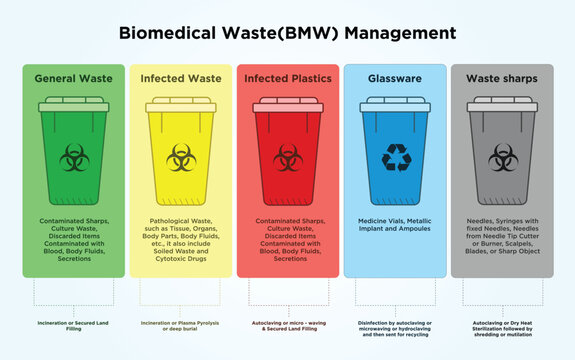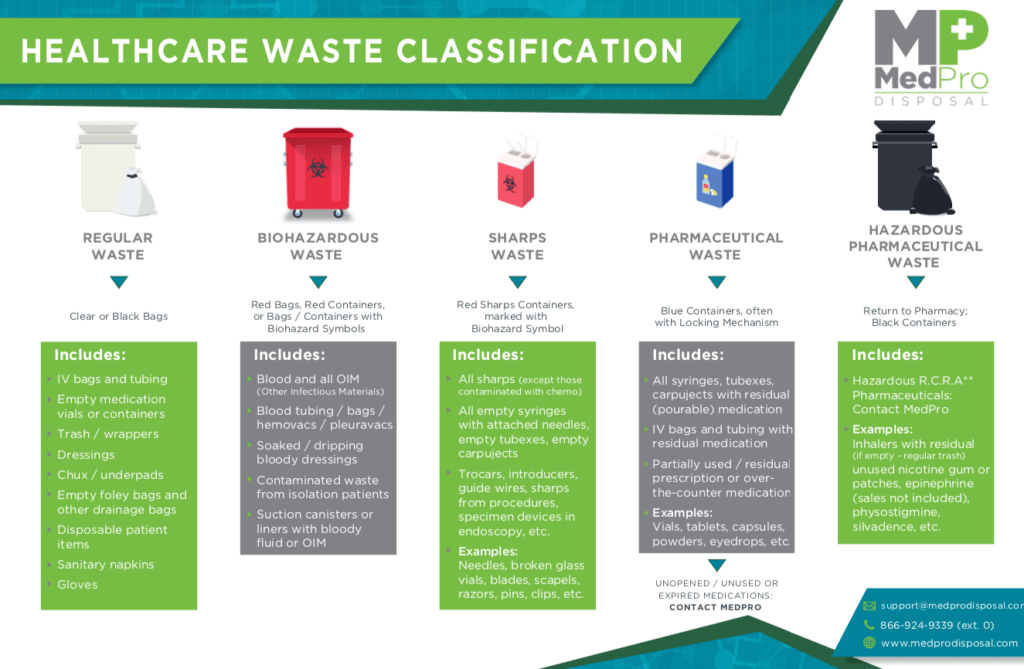Your Ally in Medical Waste Removal: Specialist Service with Environmental Care
Wiki Article
Effective Techniques of Medical Garbage Disposal
Effective techniques of medical garbage disposal are essential in preserving public wellness and ecological safety. Medical waste, including sharps, pathological waste, and pharmaceutical waste, need to be taken care of and taken care of properly to avoid the spread of infections and secure the setting. This needs adherence to stringent laws and the execution of professional waste management practices.Appropriate segregation of medical waste, safe and secure and secure storage space, effective treatment and disinfection methods, and environmentally-friendly disposal options are key components of an effective clinical garbage disposal system. Specialist waste monitoring solutions play an essential duty in making certain compliance with regulations and reducing the risks associated with improper disposal. By employing these techniques, health care facilities can add to a safer and cleaner atmosphere while protecting the well-being of the community.
Appropriate Segregation of Medical Waste
Correct partition of medical waste is vital for guaranteeing the risk-free and efficient disposal of these potentially hazardous products. Clinical waste describes any type of waste generated throughout health care activities, such as medical facilities, centers, laboratories, and research centers. It consists of a variety of materials, such as made use of needles, syringes, infected dressings, ended or unused medicines, and organic materials.By setting apart medical waste, health care centers can lessen the danger of infections, injuries, and environmental contamination. The procedure involves classifying waste into various types, such as sharps, transmittable waste, pharmaceutical waste, and non-hazardous waste. Each kind requires certain handling, packaging, and disposal techniques to avoid direct exposure to medical care workers, waste monitoring workers, and the public.
To guarantee correct segregation, healthcare centers should create clear guidelines and offer ample training to personnel. This includes enlightening employees on the different waste groups, proper packaging techniques, and the usage of appropriate containers - WasteX Medical Waste Disposal. Furthermore, clear signs and color-coding systems can be implemented to help with the identification and segregation of different waste kinds
Safe and Secure Storage Space of Medical Waste
Safe and safe and secure storage of medical waste is crucial for maintaining the honesty and containment of possibly unsafe products. Proper storage space not just secures health care employees and the basic public from direct exposure to unsafe compounds however additionally protects against ecological contamination.To make sure risk-free storage space, medical facilities must adhere to specific guidelines. Waste needs to be saved in puncture-resistant and watertight containers that are identified appropriately - medical waste disposal.
Proper segregation of clinical waste is likewise necessary for risk-free storage. Different kinds of waste, such as sharps, transmittable materials, and pharmaceutical waste, should be separated to avoid cross-contamination. This partition can be accomplished with using color-coded containers or containers.
Normal surveillance and assessment of the storage space location are important to identify any potential threats or violations. This includes monitoring for indications of damages or deterioration in the containers, ensuring appropriate ventilation, and keeping an eye on temperature and humidity levels.
Efficient Therapy and Disinfection Approaches

One generally utilized treatment approach is autoclaving, which entails subjecting the waste to high-pressure heavy steam at temperatures above 121 levels Celsius. This process successfully eliminates microbes and damages transmittable representatives, providing the waste secure for additional disposal. An additional technique is incineration, which includes shedding the waste at heats. Incineration not just removes microbes however additionally reduces the waste volume via combustion.
Chemical disinfection is another efficient approach for treating clinical waste. This method includes utilizing disinfectants such as chlorine compounds, phenolic substances, or hydrogen peroxide to kill or inactivate pathogens (WasteX Medical Waste Disposal). Chemical disinfection is frequently utilized for fluid waste, such as research laboratory examples or bodily fluids
In current years, different treatment methods such as microwave sanitation, irradiation, and biological therapy have additionally acquired attention. These approaches provide advantages such as decreased ecological effect and power consumption contrasted to typical techniques.
Environmentally-friendly Disposal Options
In the realm of medical garbage disposal, considering environmentally-friendly alternatives is important. Healthcare facilities create a significant amount of waste, including transmittable materials, drugs, and chemicals, which can posture major risks to human health and the atmosphere otherwise taken care of correctly. There are several environmentally-friendly disposal alternatives available that can help reduce these dangers.
Recycling clinical waste entails setting apart and refining certain materials for reuse or repurposing. Furthermore, some health care centers have actually applied reusing programs for specific clinical tools or devices, more lowering waste generation.
Another environmentally-friendly disposal option is waste-to-energy conversion. This approach includes converting medical waste into energy through processes like incineration or anaerobic digestion. medical waste disposal. Incineration, when done properly with sophisticated innovations, can create energy while reducing damaging discharges. Anaerobic digestion, on the other hand, breaks down organic waste in the absence of oxygen, producing biogas that can be used for electricity or heat generation.

Benefits of Expert Waste Management Solutions
One significant benefit of expert waste management solutions is the boosted efficiency in disposing and dealing with of medical waste. By using professional waste management services, medical care centers can guarantee that all clinical waste is handled and disposed of appropriately, minimizing the danger of contamination and the spread of illness.Specialist waste management services employ knowledgeable and experienced employees that are well-informed regarding the guidelines and standards for clinical garbage disposal. They have accessibility to customized tools and tools that allow them to manage various kinds of medical waste safely and efficiently. These services also have well-established treatments and protocols in position to ensure that waste is set apart, packaged, transported, and disposed of in compliance with neighborhood, state, and government guidelines.
Additionally, expert waste administration services can provide healthcare centers with detailed waste administration services. They can use services such as waste collection, treatment, transport, and disposal, customized to the certain requirements and requirements of the center. This gets over here rid of the burden of taking care of waste inside, allowing medical care personnel to concentrate on giving high quality client treatment.
Final Thought
In verdict, reliable methods of clinical waste disposal entail appropriate partition, risk-free storage space, treatment and disinfection, and environmentally-friendly disposal options (WasteX Medical Waste Disposal). These approaches guarantee the secure handling and administration of clinical waste, protecting against the spread of infections and securing the environment. Expert waste monitoring services play a critical role in carrying out these approaches and guaranteeing conformity with policies. By complying with these techniques, healthcare facilities can add to a more secure and healthier atmosphere for both individuals and the neighborhood.Medical waste, including sharps, pathological waste, and pharmaceutical waste, should be managed and disposed of effectively to protect against the spread of infections and protect the environment.Correct segregation of medical waste, safe and protected storage, efficient treatment and disinfection methods, and environmentally-friendly disposal choices are essential elements of an efficient medical waste disposal system. The process involves categorizing waste right into various kinds, such as sharps, transmittable waste, pharmaceutical waste, and non-hazardous waste. By making use of expert waste administration services, healthcare centers can make certain that all clinical waste is managed and disposed of correctly, lessening the danger of contamination and the spread of diseases.
Professional waste monitoring solutions utilize qualified and experienced workers who are well-informed about the laws and standards for medical waste disposal.
Report this wiki page